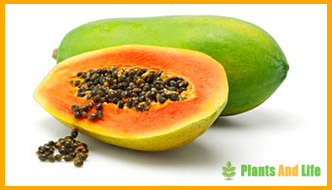
Papaya is an ovoid or rounded berry, 21 to 31 cm long, with an edible pulp. It weighs about 1 kg (and sometimes up to 5 kg). It contains many black seeds surrounded by mucilage. When ripe, papayas are yellowish green, and their juicy flesh is orange-yellow and may be of another color.
There are several varieties of papaya trees that have been genetically modified by transgenesis to resist the papaya ring spot virus, thanks to an RNA interference mechanism. These papayas known as 'Rainbow' or 'SunUp', are authorized for cultivation only in the United States (Hawaii) and for importation into Japan and Canada. Field trials have also been authorized in Thailand or Australia.
On the other hand, varieties of papermas of the hermaphrodite types form rather longer elongated papayas and of yellow to orange flesh while the dioecious varieties, like the wild type, make papayas more oblong and of orange to red flesh and which are more tasty because more fragrant. It is also possible to confit pieces of papaya.
Traditional uses
In the pre-Columbian era, the Caribbean peoples used the green fruit as a poultice against reddened areas of the skin and against gastrointestinal disorders. To tenderize the raw meat, they wrapped it in papaya leaves before consuming it. This use has long been a tradition in the West Indies.
In all the Caribbean, the seeds and the latex of the fruit are recommended as a dewormer. Fruit juice or an infusion of the leaves is traditionally recommended in liver diseases, dyspepsias, colic and stomach ulcers.
In external use, the crushed fruit is applied to boils, abscesses. Latex applied as a hydrogel on burns promotes healing.
Latex in pharmacology
The latex is collected by incising the still green fruits. It coagulates quickly and is recovered by scraping and drying in the sun or artificially. From the papaya juice thus obtained, a touching protease called papain is extracted, formed from 21 amino acids and chymopapain, used in chemionucleolysis (treatment of herniated discs). Papain has been listed in the French codex since 1937.
According to Bruneton, "Papain, alone or in combination, is offered in digestive therapy and dietetics as an alternative enzyme in the event of gastric or duodenal insufficiency: symptomatic treatment of dyspeptic disorders. In local use, it is part of the adjunctive treatment formulation for conditions limited to the mucosa of the oral cavity and the oropharynx, postoperative operations, accidental oral lesions; detergent and healing, it is then combined with an antibiotic and lysozyme.
Food
- It also serves as a base for Thai salad, som tam or Vietnamese gỏi
- The latex of green papaya can also be used in the manufacture of chewing gum.
- The papain found in green papaya tenderizes octopus flesh by marinating it with pieces of green papaya.


